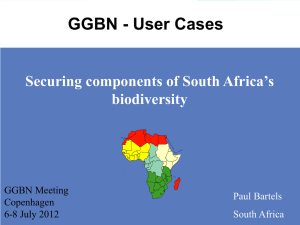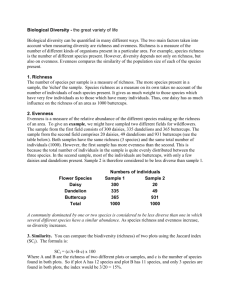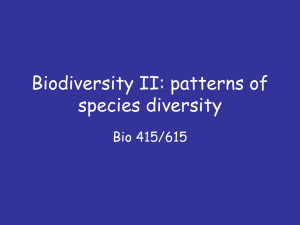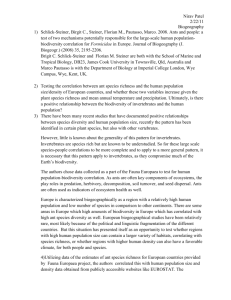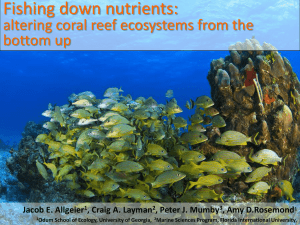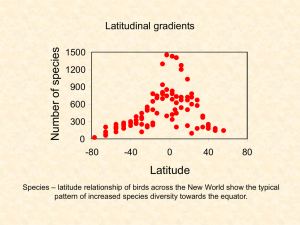Function and diversity
advertisement
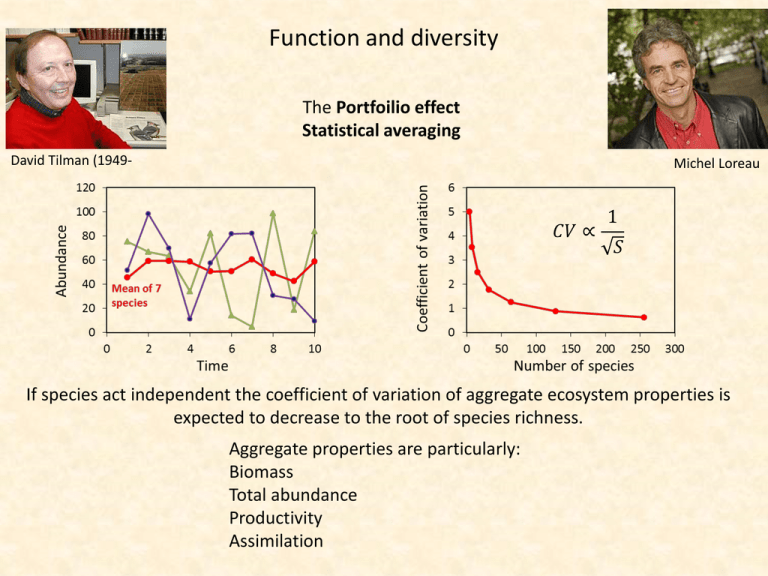
Function and diversity The Portfoilio effect Statistical averaging David Tilman (1949- Michel Loreau 𝐶𝑉 ∝ 1 𝑆 If species act independent the coefficient of variation of aggregate ecosystem properties is expected to decrease to the root of species richness. Aggregate properties are particularly: Biomass Total abundance Productivity Assimilation The law of the minimum and ecosystem functioning Average performance without limiting effects Performance with limiting effects Species at minimum limit the functioning of ecosystem properties 𝐶𝑉 ∝ Point of fast change 1 𝑆 Point of fast change Ecosystem functioning increases nonlineary with species richness. This model works if species form functional guilds whose members have equivalent properties. The law of the minimum Limiting factors: Light Water Space Nutrients Water is the limiting factor for photosynthetic rates with respect to temperature Temperature Precipitation Photosynthetic activity Justus von Liebig (1803-1873) Euryoecious organisms tolerate a wider range of habitat conditions. Stenoecious organisms have limited tolerance. – Longofterm ecological research at Cedar Minnesota Variance andLTER covariance native savannah plants at Cedar CreekCreek, in relation to species diversity. 147 experimental plots at Cedar Creek in Minnesota 120 samples from undisturbed native Minnesota grasslands. Tilman 1999, Ecology 80: 1455-1474 100 50 40 30 20 y = 12.8Ln(x) + 11.5 10 R 2 = 0.96 0 Total plant cover (%) Total plant cover (%) 60 80 60 40 20 y = 28.6Ln(x) - 10.7 R 2 = 0.77 0 0 10 20 Number of species 0 10 20 Number of species Results of the BIODEPTH experiment Source of variation Locality Species richness Functional group richness Assemblage Locality x Assemblage Residual Total SS 12.4 6.6 1.17 17.1 2.08 4.46 43.81 % SS 28.3% 15.1% 2.7% 39.0% 4.7% 10.2% F 24.7 7.15 6.34 1.29 3.77 p < 0.00001 < 0.00001 0.002 0.2 < 0.00001 Grassland aboveground biomass depends on several factors among which locality, diversity and functional diversity are of major importance. Hector et al. 1999, Science 286, 1123-1127 Grassland productivity declines as the number of functional groups decreases. z z Biodiversity and bacterial activity 30 Bacterial respiration Bacterial respiration 30 25 20 15 10 5 28 days experimental time 0 25 Day 0-7 20 15 Day 7-14 10 5 Day 14-28 0 0 20 40 60 Species richness 80 0 20 40 60 80 Species richness Bell et al. 2005, Nature 436: 1157-1160 Bacterial species richness influences respiration of soils from beech stands. Respiration is not a linear function of bacterial richness This points to the existence of redundant species The current state of art: • Ecosystem functioning depends not such much on species richness but on richness of functional groups (ecologigal guilds) • Productivity increases with plant functional group richness • Stability increases with plant functional group richness • Drought restistance increase with plant functional group richness • Bacterial species richness promotes efficiency of bacterial services like breakdown of pollutants • Decomposition increases with eukaryotic species richness • Total bacterial activity increases with bacterial foodweb complexity • Stability decreases with dispersal among patches • Habitat fragmentation and species richness act synergistically and decrease stability How do diversity and stability depend on productivity? Species richness peaks often at intermediate productivity 250 Palearctic birds Evapotranspiration is the sum of evaporation and transpiration, hence the total amount of water going from living organismas and the soil into the atmosphere. 200 S 150 100 50 It is a measure of total energy input. 0 0 500 1000 Evapotranspiration 1500 Hawkins et al. 2003, Ecology 84: 3105-3117 250 Palearctic butterflies 200 150 S Species richness often peaks at intermediate degrees of evapotransiration. 100 50 0 0 500 1000 Evapotranspiration 1500 Hawkins et al. 2003, Ecology 84: 3105-3117 Bird species numbers are correlated with annual evapotranspiration and temperature. The influence of productivity on the species richness of plants z 80 Percent 100 60 Continental scale 40 20 0 Humped Positive Negative Ushaped None z 80 Percent 100 60 Regional 40 20 0 Humped Positive Negative Ushaped None z Percent 100 80 60 Local scale 40 20 Gillman, Wright, 2006, Ecology 87: 1234-1243 Meta-analysis found very variable patterns of the productivity species richness relationship at local scales. 0 Humped Positive Negative Ushaped None Above the local scale plant species richness increases with productivity. Patterns of fish species richness in China’s lakes Zhao et al. 2006, Gl. Ecol. Biogeogr. 2 R = 0.75 S S 140 120 100 80 60 40 20 0 1 10 100 1000 140 120 100 80 60 40 20 0 10000 2 R = 0.34 1 140 120 100 80 60 40 20 0 0.001 0.1 100 1000 Maximum depth [m] S S Altitude [m] 10 10 1000 8 3 Lake volume [10 m ] 140 120 100 80 60 40 20 0 0.1 10 1000 100000 2 Lake area [km ] Fish species richness scales significantly with altitude and maximum depth of a lake Lake volume is of minor importance 1000 1000 2 2 R = 0.43 R = 0.57 100 S S 100 10 10 1 1 -10 0 10 20 30 0 1000 1500 Annual potential evapotranspiration [mm] Mean annual temperature 1000 500 1000 2 2 R = 0.53 R = 0.40 100 S S 100 10 10 1 1 0 500 1000 Annual actual evapotranspiration [mm] 0 500 1000 1500 2000 Annual precipitation [mm] Main determinants of fish species richness were annual PET, altitude, and lake area. Productivity and stability Are tropical populations more stable than populations in temperate or arctic regions? 5 CV 4 3 2 1 0 0 20 40 60 80 There is no general latitudinal trend in population variability Taxon Hemiptera Hymenoptera Lepidoptera Falconiformes Galliformes Passeriformes Strigiformes Artiodactyla Carnivora Insectivora Lagomorpha Rodentia r 0.01 -0.72 -0.37 -0.85 0.22 -0.28 0.7 0.21 0.71 -0.09 -0.99 0.32 P >0.1 <0.01 <0.001 <0.01 >0.1 <0.01 >0.1 >0.1 <0.01 >0.1 <0.001 <0.01 Vazquez, Stevens, 2004, Am. Nat 164: E1-E19 CV Latitude 5 4 3 2 1 0
